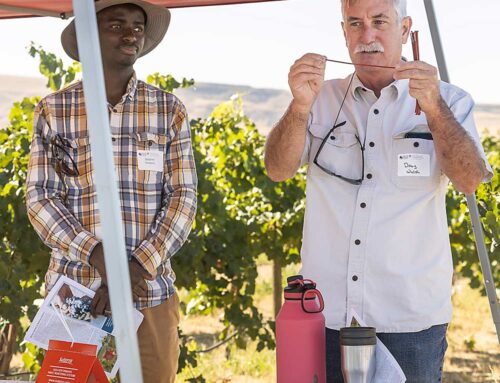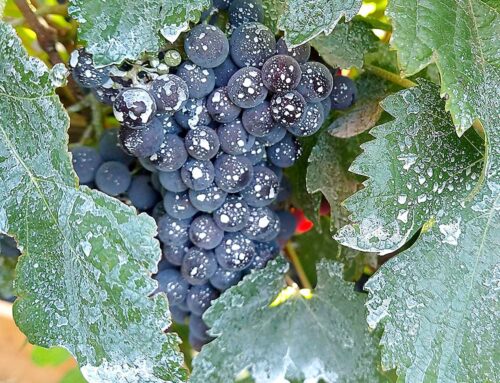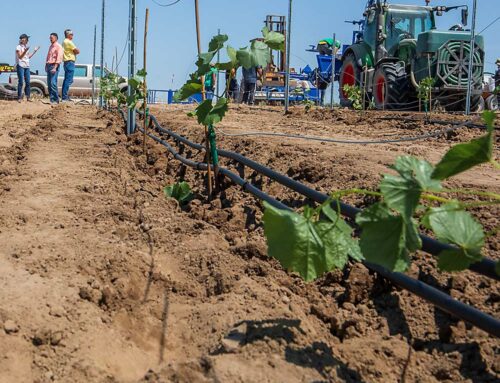
Dr. Matthew Whiting
Washington State University
Good quality sweet cherries can be produced using less water, says a Washington State University horticulturist. Based on a three-year research project studying the effects of season long-deficit irrigation and partial root-zone drying on sweet cherry trees, Dr. Matthew Whiting, WSU horticulturist at the Irrigated Agriculture Research and Extension Center in Prosser, concluded that water resources may be conserved in most commercial orchards without negatively affecting fruit quality or yield.
“It’s a myth that cherry trees are very sensitive to water and they can’t be stressed at all,” he said. “Cherry trees appear to be pretty resilient and weren’t particularly susceptible to low soil water content. Growers can save water without hurting quality.”
The project, supported by the Washington Tree Fruit Research Commission, compared two reduced-input irrigation strategies on mature bearing Bing cherry trees grown on Mazzard, Gisela 5, and Gisela 6 rootstocks. In the control, water sufficient to replace 100 percent of that lost by evapotranspiration was applied.
In the deficit irrigation treatment, water was applied to the entire root zone but at 50 percent evapotranspiration replacement, and in the partial root zone drying treatment, water was applied at 50 percent ET, but only to one-half of each tree’s root zone during each irrigation event. Subsequent irrigation events watered the other root zone, alternating between the dry and wet root zone halves.
Yield and fruit quality were measured at harvest. Also, gas exchange (transpiration and net photosynthesis) within selected trees was determined. Dr. Roberto Núñez-Elisea of Oregon State University contributed to the project, conducting research at cherry orchards of the Mid-Columbia Agricultural Research and Extension Center in Hood River.
A similar project looking at deficit irrigation and partial root-zone drying in apples was also conducted by Whiting and Dr. Horst Caspari of Colorado State University using potted, split-rooted apple trees as well as trees in field trials.
Partial root-zone drying, a reduced-input technique developed in Australia, uses two separate irrigation lines placed on either side of the plant. Water is alternated between sides, watering one side while the other is permitted to dry and become stressed.
Findings
Though there were subtle differences between the two reduced-input irrigation treatments, with the partial root-zone drying producing slightly better quality fruit compared to deficit irrigation in two of three years, Whiting said that the differences “may not in the end justify changing to a different system” that uses two irrigation lines. Partial root-zone drying provided significant vigor control of trees on Mazzard and Gisela 5, but not for trees on Gisela 6, he reported.
“Gisela rootstocks were no more or less susceptible to water stress than Mazzard,” he said. “We thought that with Gisela 5’s smaller canopy and smaller root zone it would be more susceptible, but it all seemed to balance out. Across the rootstocks, neither treatment significantly affected fruit quality compared to the control.”
Fruit and shoot growth rates were affected inconsistently and only slightly by reduced water input. Trunk expansion was not affected by irrigation treatment. Also unaffected by irrigation treatments were components of gas exchange, including net photosynthesis, transpiration, and stomatal conductance.
The reduced input of water didn’t initiate more flowers in the next season or impact the crop in the following spring. At the end of the season, the partial root-zone drying treatment had higher water content compared to the deficit irrigation.
Whiting explained that there was greater evaporation from the soil surface in the deficit irrigation treatment, which used the same volume of water as the partial root-zone drying received, but in twice the amount of area. “So there were some water savings between the two systems,” he said.
Whiting added that the partial root-zone drying may improve water use efficiency compared to deficit irrigation, however, this wasn’t determined by his research. Though the research showed that less water could be used on cherry trees, there are still some questions unanswered.
Data collected to indicate plant stress showed that the trees did not experience significant physiological stress, despite low soil moisture content. “What we don’t know is when does a cherry tree become stressed and how do you measure that?” Whiting said.
“That’s the most fundamental question.” Whiting noted that it was difficult to achieve perceptible stress in cherry trees during the preharvest window because the soil profile was saturated from sprinklers used for frost protection. During the preharvest window, despite applying half the normal amount of water, he observed no effect in stem water potential stress.
“Most orchardists provide frost protection from water,” he said. “You start the growing season with the soil soaked, with a saturated profile.” There’s very little evaporative demand during the spring to use up the water. There are no leaves on the tree, and temperatures are very cool.But after harvest, it’s a different picture. Temperatures are high, as are evaporative demands. “Then you can see significant stress. After harvest, we did see a reduction in photosynthesis.”






Leave A Comment